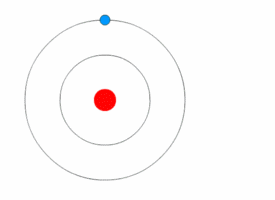Atomic Theory
Claimed by: Caitlyn Caggia (ccaggia3)
Atomic theory states that matter is composed of discrete units, called atoms. The word "atom" comes from the Greek word for uncuttable, atomos. Scientists later discovered that atoms were indeed able to be broken into subatomic, or elementary, particles including protons, neutrons, and electrons. Atomic theory has evolved greatly over time, but the most recent model stems from quantum mechanics.
History
John Dalton: The Law of Multiple Proportions and Atomic Mass

Working from the conservation of mass principle, chemist John Dalton determined the law of multiple proportions to understand how different elements combined in compounds. In 1803, he proposed that each element of the periodic table was composed of identical components, atoms, that were unique to each element. He also suggested that these atoms were not created nor destroyed when one element was combined with another. Dalton's empirical, experimentally-based work marked the first scientific theory of the atom.
Dalton proposed a list of atomic weights in 1805. However, Dalton failed to recognize natural tendencies of elements in nature (for example, oxygen typically exists as a diatomic molecule as O_2). Dalton was unable to distinguish between atoms and molecules (groups of atoms).
Amedeo Avogadro: Avogadro's Law
In 1811, Amedeo Avogadro studied gases and determined that the amount of volume a gas occupies is not determined by the mass of the gas. This allowed Avogadro to take more accurate atomic measurements of gases than Dalton, and differentiate atoms from molecules.
Robert Brown: Brownian Motion
A Scottish botanist, Robert Brown, studied the motion of tiny pollen particles in water in 1827. The particles followed complex paths, dubbed Brownian Motion. As early as 1905, Albert Einstein used Brownian Motion to predict the size of atoms and molecules.
J.J. Thomson: The Plum-Pudding Model and Electrons

Through his work with cathode rays, J.J. Thomson discovered the electron in 1897, and was the first to learn that atoms weren't actually "uncuttable" as initially thought. Thomson knew that atoms had a net neutral charge, but he only knew that negative particles existed. Thus, Thomson developed the "plum-pudding" model of negatively charged electrons floating in a sea of positive charge. (He likened the relationship of electrons to the sea of positive charge to that of plums in plum pudding.)
Ernest Rutherford: Gold Foil Experiment and the Nucleus
In 1909, one of Thomson's students, Ernest Rutherford, determined that the positive charge of atoms was located in a central nucleus. He shot small, positively charged alpha particles at thin sheets of gold foil and noted that some particles were sharply deflected. This deflection could only occur if the positive components of atoms were located in a small area, which Rutherford assumed to be the center. He proposed a planetary model of atoms where a cloud of electrons surrounded a central, positively charged nucleus.
Niels Bohr: Quantum Physics

As quantum mechanics progressed through the work of Albert Einstein and Max Planck, Niels Bohr updated the atomic model in 1913 to account for quantum phenomena. Bohr suggested that electrostatic forces kept electrons in circular orbit around the positively charged central nucleus. In support of his theory, Bohr examined the behavior of electrons in hydrogen molecules and noted that they followed distinct energy levels. When an electron changed energy levels, it gained or lost energy, which could be emitted in the form of light. While the Bohr model holds true for hydrogen, it isn't accurate for multi-electron elements.
=
Examples
Be sure to show all steps in your solution and include diagrams whenever possible
Simple
Middling
Difficult
Connectedness
While classical physics applies to large objects moving much slower than the speed of light, modern physics deals with special cases of tiny objects, like atoms, subject to relativistic effects. Atomic theory is vital to understanding many quantum physics concepts that are covered in both Physics 2211 and 2212.
See also
Are there related topics or categories in this wiki resource for the curious reader to explore? How does this topic fit into that context?
Further reading
Books, Articles or other print media on this topic
External links
Internet resources on this topic
References
Chapter 30 of OpenStax Textbook
Physics Portal page on Atomic Theory